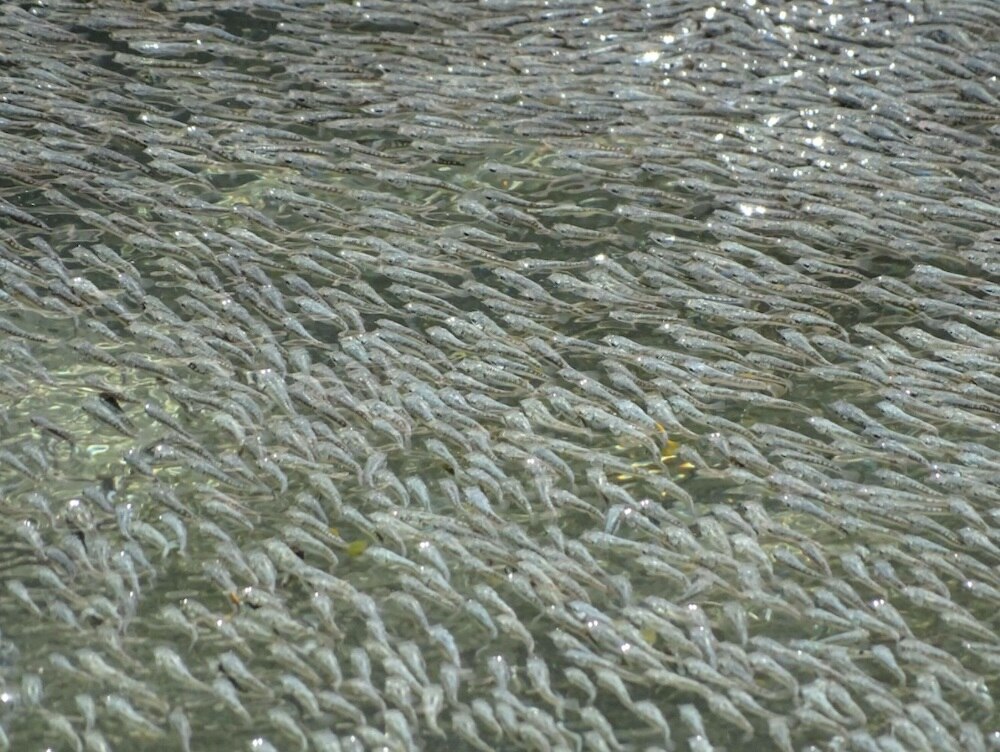Create a free profile to get unlimited access to exclusive videos, sweepstakes, and more!
By their powers combined, fish act as waterbenders to defend from predators
If you want to move the world around you, it helps to have a few thousand friends.

It’s hard being a small fish in a big pond, or lake, or river system. Mostly, it’s just hard being a small fish. It’s even harder when predatory birds swoop down from above to eat you and your friends alive. What’s a small fish to do? Like so many instances involving an imbalance of power, sometimes the only solution is collective action.
Sulfur mollies — small freshwater fish who live in sulfur-rich hot springs — combine their powers when threatened to create waves along the surface of the water. These waves act as a defensive strategy against predatory birds, according to a recent paper published in the journal Current Biology.
David Bierbach from the Division of Biology and Ecology of Fishes at Humboldt University, and colleagues, were studying sulfur mollies in their uniquely toxic habitat when they first observed this bizarre wave generating behavior.
“We were looking at the sulfur mollies’ adaptation that allows them to withstand the toxic sulfidic water, when we realized that they produce these waves. Whenever we came close to the river or pools, they would start to wave,” Bierbach told SYFY WIRE.
These schools of fish, numbering in the thousands, generated waves by diving deeper into the water column in a rhythmic fashion. Once waving began, it would continue for up to two minutes before ceasing.
Because sulfur mollies live in a toxic water environment with a relatively low oxygen content, they have adapted to rely more heavily on surface respiration. An unfortunate consequence of this behavior is that it leaves the fish more vulnerable to airborne predators. Several bird species, including kiskadees and kingfishers, have evolved to hunt the small fish by submerging either their beaks or whole bodies into the water in swooping attacks. The cooperative wave generation appears to have emerged as a way to limit losses.
Precisely why the waves negatively impact the hunting behavior of birds isn’t wholly understood. It may confuse the birds, making it more difficult for them to accurately target prey, or it may just add an unusual element to the environment which the birds stop to investigate. In either case, the total number of fish devoured decreases when wave generation is in effect.
“Both investigated bird species are impacted similarly by the fish waves, in that they prolonged the time to attack a second time. Kiskadees even had decreased hunting success, this could be due to differences in their hunting techniques,” Bierbach said.
Kiskadees hunt by entering their beaks into the water, while kingfishers submerge their entire bodies. As a result, the waves seem to disproportionately impact kiskadee hunting attempts. Conversely, kingfishers saw a higher rate of success which might have been a result of their improved patience. The duration between attacks was longer in kingfishers. However, while kiskadees had a lower probability of success, more frequent attacks made up the gap resulting in the total number of successful attacks being similar in both species.
Scientists confirmed the deterrent effect of wave generation by comparing schools of mollies who exhibited the behavior against schools who didn’t. In those populations who made waves, fewer overall fish were consumed.
Observations showed that waves are initiated by a single fish, usually the individual closest to the initial attack. As they dive into the water column, their tails disturb the water surface. Nearby fish then mimic the diving behavior and the message travels outward throughout the school. The rhythmic disturbance of the water generates waves similar to those seen when a stone is dropped in the water.
“Copying the actions of visible neighbors is one important part, but also how many neighbors must be seen diving before an individual initiates diving,” Bierbach said. “We don’t know yet the exact mechanism.”
The coordinated efforts of these small fish are a natural example of what each of us knows deep down. When you’re under attack, be noisy and uncooperative. Make waves if you have to. The power is yours.


























